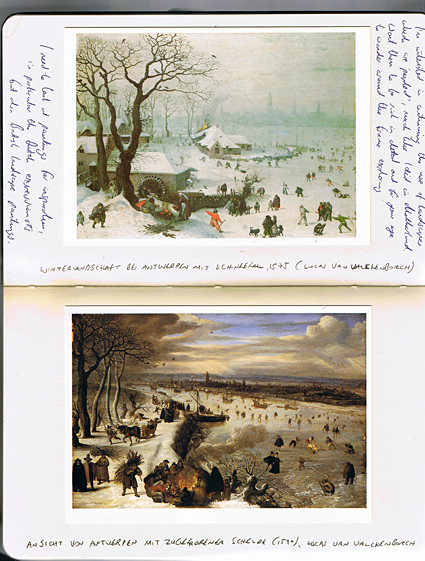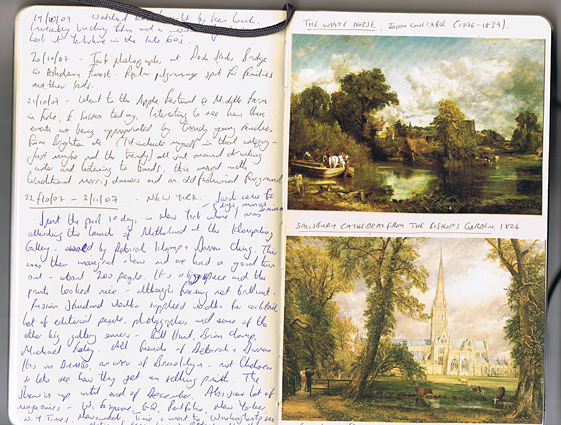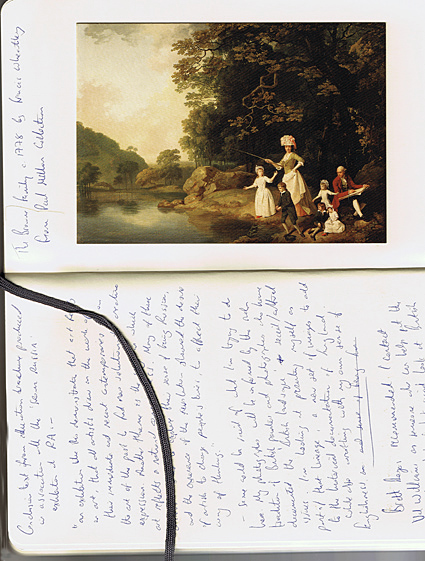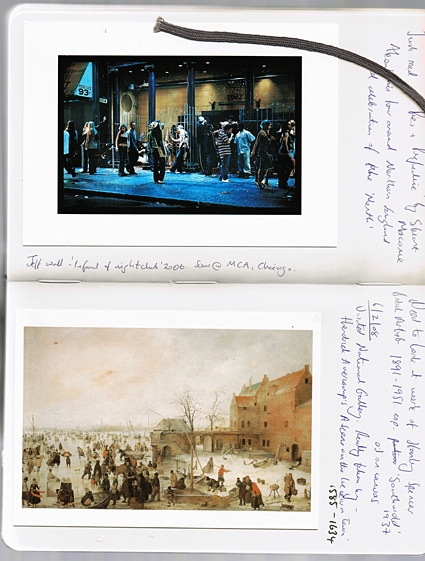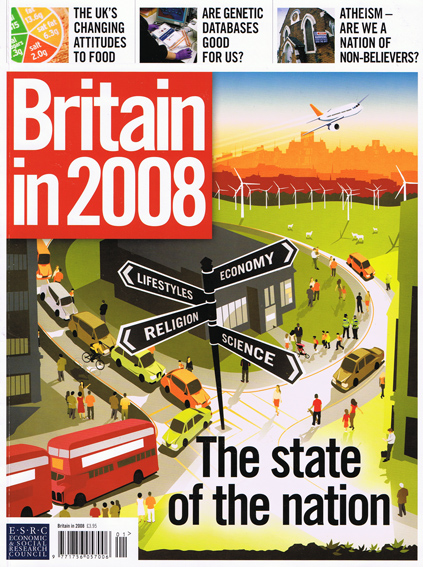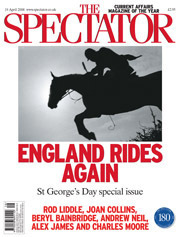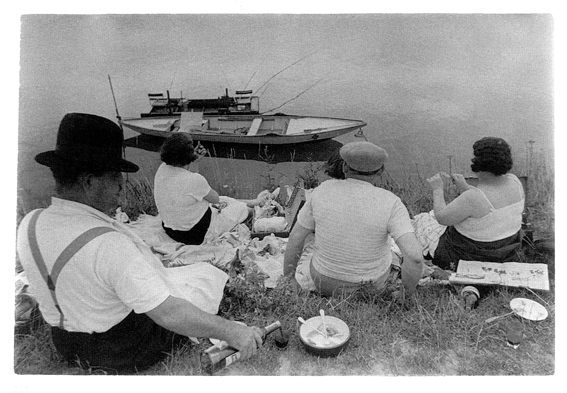On a trip back from Amsterdam recently I came across a newspaper cutting with an article entitled ‘Man goes golfing after jet crash destroys home’ (see cutting in my scrap book below). A story that goes some way to highlight the sometimes bizarre devotion the English have for sporting pastimes. Eddie Harman, 72, was in Spain when he was told that a plane had crashed into his home in Farnborough, killing five people. His wife came home from a separate holiday to cope with the aftermath, however, Mr Harman played a round of golf before returning to England. He is quoted as saying “I think a round of golf helped take my mind off things.”
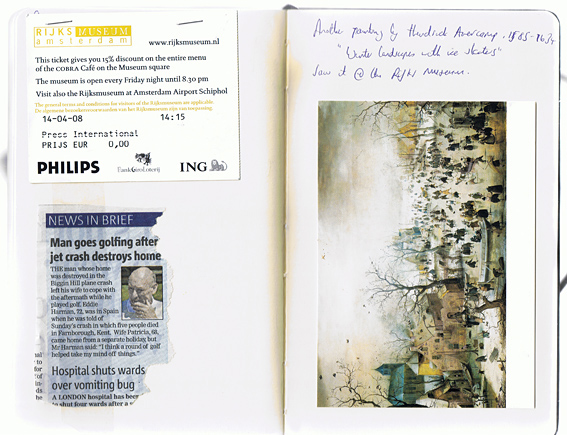
While I was in Amsterdam I visited the Rijks Museum. Although the building is currently undergoing major renovation, there is still an opportunity to see a selection of the museum’s masterpieces. A small but wonderful display of Dutch paintings. Given my current interest in leisure, I was particularly taken by Hendrick Avercamp’s ‘Winter landscape with iceskaters’. Avercamp (1585-1634) was one of the first landscape painters of the 17th-century Dutch school, and the most famous exponent of the winter landscape. He was deaf and dumb and known as de Stomme van Kampen
(the mute of Kampen).
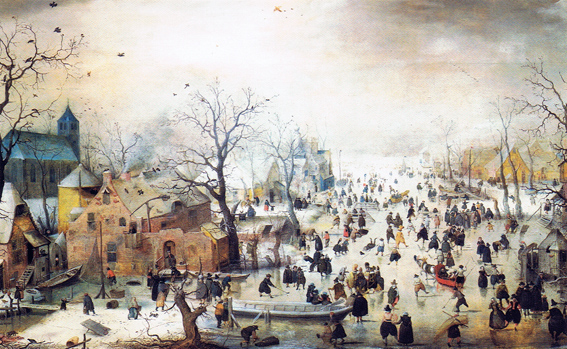
Winter Landscape with Iceskaters, c. 1608
In this painting, one of the earliest large winter landscapes in the Rijksmuseum, crowds of people are depicted on the ice in a scene that stretches far into the distance. There is considerable variety among the figures, both in clothing and in what they are doing. Some of those portrayed are having fun, while others appear to be working. Avercamp has included several daring details, such as the couple making love, the bare buttocks and the man urinating.
Another wonderful example of Avercamp’s winter landscapes is: ‘A winter scene with skaters near a castle’ (1585), reproduced here-
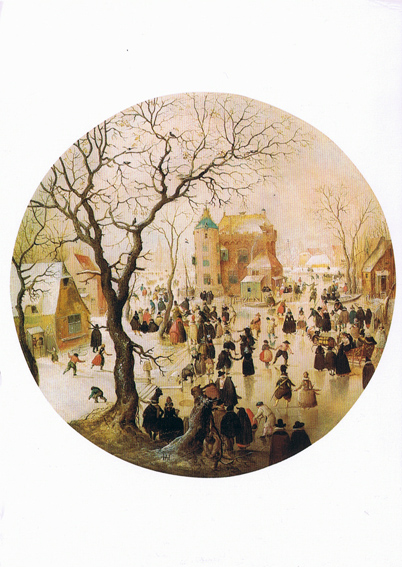
I’m going to look at paintings in more detail in a future post. In the meantime, if you have any suggestions of paintings that depict scenes of leisure and pastimes, particularly in the English landscape, please post them below.
A few for starters –
William Powell Frith ‘Derby Day’ (1856-8)
Philip Wilson Steer ‘A Procession of Yachts’ (1892-3)
James Tissot ‘Holyday’ (c. 1876)
Posted in ART & LEISURE, INSPIRATION, TRIP LOGISTICS | Comments Off on A PAGE FROM MY SCRAP BOOK
Happy St. George’s Day!
Which seems to be a more popular thing to be celebrating this year according to Philip Johnston in today’s Daily Telegraph.
It certainly appears that some of our politicians have decided to embrace St.George’s Day. You do have to ask yourself whether this has more to do with diverting attention (during a very bad week for Labour leader Gordon Brown, he announces that the St.George’s flag will fly over 10 Downing Street for the first time in recent memory) or raising attention (trailing in the polls London Mayor Ken Livingstone – who has rarely organised events in London to celebrate the 23rd April, preferring instead St. Patrick’s Day – this year is pulling out all the stops with events across the capital).
While political singer Billy Bragg writes passionately in today’s Guardian about why we should embrace St. George’s Day under the headline “Let’s celebrate what it means to be English”. And here it is-
“The notion of a patriotic celebration of St George’s Day is something that many English people feel ambiguous about, owing to the historical connotations that it carries. For a long time we’ve flown the union flag rather than the flag of Saint George – but a mixture of a greater confidence in Scotland and the recent influx of immigrants has put the English identity back on the agenda. It is possible for St George’s Day to become a celebration, but whether or not it can become a national day in the way the Americans have, I very much doubt; we just wouldn’t feel comfortable with a day when we have all got to salute the flag. The belligerence within the English tradition is still a fresh memory and for some people the national flag is associated with football violence.
We need to find a way to overcome that reticence and repossess the symbols of what it means to be English. St George’s Day can help us do that if we can make it less inward looking and more like St Patrick’s Day where everyone can be Irish for the day, wherever they come from.
What we lack is a confidence, not so much about who we are, more about whether it’s okay to celebrate being English. We need to stop being embarrassed about our home and find a way to celebrate the things about it that we love – both to respect the locals and to build bridges with newcomers.
Multiculturalism isn’t about celebrating everybody’s culture but our own. We have to be present, not least because as hosts we provide the framework for our diversity to flourish. If you accept the idea that national identity is personal, then it is down to each of us to find something to celebrate on April 23. Let those people who feel strongly about the traditional ideas, celebrate them in their traditional way. Let others find aspects of Englishness they feel comfortable with.
My hunch is that Englishness has more to do with space rather than race – and by having a day when we can celebrate the things that make us feel we belong, we can begin to reclaim our identity from those who would use our flag to intimidate and divide.”
© Billy Bragg, The Guardian, Wednesday April 23 2008
Posted in ENGLISHNESS | 1 Comment »
The English Department at Bristol University has a specific course on Englishness for final year students, which sounds pretty interesting.
Introduction
What does it mean to be English – not British, but specifically English – and why should it matter? What national and cultural qualities does the word identify, and what has it meant in the past? Perhaps most importantly, what is the future of Englishness, and what is the future of England?
These are pressing cultural issues, and many literary critics, historians, and writers have recently turned their attention to such questions. They are also concerns that have a long history in English Literature, and have been debated and discussed for centuries. This course offers an introduction to Englishness, both its history and its literature, and presents a diverse (and ambitious) variety of material from the twelfth century to the present day. It gives a broad historical overview of certain English figures, such as King Arthur and Robin Hood, develops certain themes that characterize English identity – the Gothic, Landscape, Empire, Temper – and examines the literature of historical events such as the First and Second World Wars. The course argues that historically, Englishness has been characterized by mongrelism, hybridity, the spirit of compromise and adaptation, and linguistic capaciousness and absorption, and endeavours to explain why certain attitudes persist and how others change, and ultimately what constitutes Englishness.
For keen readers among you, here is their recommended reading list!
Peter Ackroyd, Albion: The Origins of the English Imagination (Viking, 2002)
Jane Austen, Pride and Prejudice (Oxford, 2004; ed. Fiona Stafford)
Julian Barnes, England, England (Picador, 1999)
Geoffrey Hill, Collected Poems (Penguin, 1995)
Rudyard Kipling, The Jungle Book, ed. W.W. Robson (Oxford World’s Classics, 1998)
Hanif Kureishi, The Buddha of Suburbia (Faber & Faber, 1991)
Spike Milligan, Robin Hood According to Spike Milligan (Virgin, 1999)
George Orwell, Coming Up for Air and Keep the Aspidistra Flying in Complete Novels (Penguin, 2000).
William Shakespeare, Richard II, Henry IV 1& 2, Henry V (Arden edn of RII, ed. Charles Forker; Oxford edns of remainder, ed. David Bevington, René Weis, Gary Taylor, respectively)
Bram Stoker, Dracula, ed. Maurice Hindle (Penguin, 1993)
Alfred, Lord Tennyson, Idylls of the King and a Selection of Poems, ed. J.M. Gray (Penguin, 1996)
J.R.R. Tolkien, The Lord of the Rings (Allen and Unwin, 1954-5)
P. G. Wodehouse, Uncle Fred in the Springtime (Penguin, 2004)
Michael Wood, In Search of England (Penguin, 2000)
Essays
Due in weeks 4 and 12
Suggested Weekly Plan [some selections may change]
1. Reading Week
2. Introduction: Robin Hood
Julian Barnes, England, England (Picador, 1999)
Spike Milligan, Robin Hood According to Spike Milligan (Virgin, 1999)
‘Robin Hood and Guy of Gisborn’ [course reader]
Michael Wood, ‘Merrie Englande: The Legende of Robin Hood’ in In Search of England (Penguin, 2000), 71-90.
3. Anglo-Saxon Origins
Benedict Anderson, Imagined Communities (Verso, 1991), 1-46 [course reader]
The Battle of Maldon (Norton I, 103)
Beowulf, trans. Seamus Heaney (Norton I, 29)
Thorlac Turville-Petre, ‘The Nation’ in England and the Nation: Language, Literature, and National Identity, 1290-1340 (Clarendon, 1996), 1-26 [course reader]
T.A. Shippey, ‘The Undeveloped Image: Anglo-Saxon in Popular Consciousness from Turner to Tolkien’ in Literary Appropriations of the Anglo-Saxons from the Thirteenth to the Twentieth Century (CUP, 2000), 215-36 [course reader]
J.R.R. Tolkien, ‘Beowulf: The Monsters and the Critics’, Proceedings of the British Academy 22 (1936) [course reader]
Michael Wood, ‘The Norman Yoke’ and ‘When Was England England?’ in In Search of England, 1-22, 91-106
4. King Arthur
Geoffrey of Monmouth (Norton I, 115)
Layamon, from Brut (Norton I, 122)
‘The Myth of Arthur’s Return’ (Norton I, 124)
Thomas Malory, Morte Darthur (Norton I, 419)
William Morris (Norton II, 1605)
Alfred, Lord Tennyson, Idylls of the King and a Selection of Poems, ed. J.M. Gray (Penguin, 1996): focus on the ‘Dedication’, ‘The Coming of Arthur’, ‘The Holy Grail’, ‘The Passing of Arthur’, and ‘To the Queen’
[Tennyson, Idylls of the King (Norton II, 1282)]
Michael Wood, ‘Glastonbury, the Grail and the Isle of Avalon’ in In Search of England, 43-70
5. Reflections [essay week]
Geoffrey Hill, Collected Poems (Penguin, 1995) [especially ‘Mercian Hymns’, 105-34]
[Geoffrey Hill (Norton II, 2717)]
Philip Larkin (Norton II, 2564)
6. Shakespeare and History
Richard II, Henry IV 1 & 2, Henry V (Arden edn of RII, ed. Charles Forker; Oxford edns of remainder, ed. David Bevington, René Weis, Gary Taylor, respectively)
Make sure you also study the passages from Holinshed in these editions
7. Gothic
Edmund Burke, from Reflections on the Revolution in France (Norton II, 121); ‘A Philosophical Enquiry into the Origin of Our Ideas of the Sublime and Beautiful’ [course reader]
Samuel Johnson, Prefaces to Dictionary and Shakespeare, and Lives (Norton I, 2719)
John Ruskin (Norton II, 1425)
Bram Stoker, Dracula, ed. Maurice Hindle (Penguin, 1993)
8. Romantic Ecology
William Blake, ‘And did those feet’ (Norton II, 85)
John Clare (Norton II, 802)
Robert Coll, ‘England as a Garden’ in The Identity of England (OUP, 2002), 203-11.
William Cowper (Norton I, 2875)
John Keats, ‘To Autumn’ (Norton II, 872)
Andrew Marvell, Garden Poems and ‘Upon Appleton House’ (Norton I, 1694, 1704)
James Thomson (Norton I, 2822)
William Wordsworth, The Prelude (Norton II, 303)
9. Temper and Class
Jane Austen, Pride and Prejudice (Oxford, 2004; ed. Fiona Stafford)
Daniel Defoe, ‘The True-Born Englishman’ (course reader)
Jeremy Paxman, ‘The Ideal Englishman’, in The English (Penguin, 1999), 176-206 [course reader]
P. G. Wodehouse, Uncle Fred in the Springtime (Penguin, 2004)
10. Empire
Empire (Norton II, 2017)
Benedict Anderson, ‘Census, Map, Museum’ in Imagined Communities, 163-86 [course reader]
Rudyard Kipling (Norton II, 1863); The Jungle Book, ed. W.W. Robson (Oxford World’s Classics, 1998)
Hanif Kureishi, The Buddha of Suburbia (Faber & Faber, 1991)
Salman Rushdie, Imaginary Homelands (Penguin, 1992) [course reader]
Michael Wood, ‘Epilogue: An English Family’ in In Search of England, 292-306
11. The Wars
Poetry of the Great War (Norton II, 2048)
Poetry of the Second World War (Norton II, 2525)
George Orwell (Norton II, 2456)
George Orwell, Coming Up for Air and Keep the Aspidistra Flying in Complete Novels (Penguin, 2000)
12. Reinventing the Mythology of England
Chris Hopkins, ‘Tolkien and Englishness’ in Proceedings of the J.R.R. Tolkien Centenary Conference, ed. Reynolds and Goodnight, 278-80 (course reader)
J.R.R. Tolkien, The Lord of the Rings (Allen and Unwin, 1954-5) [especially descriptions of the Shire in books one and six]
Further Reading
Benedict Anderson, Imagined Communities (Verso, 1991)
Antony Easthope, Englishness and National Culture (Routledge, 1998)
Jonathan Bate, Romantic Ecology (Routledge, 1991)
Jonathan Bate, The Song of the Earth (Picador, 2001)
Ian Baucom, Out of Place: Englishness, Empire and the Locations of Identity (Princeton University Press, 1998)
Angus Calder, The Myth of the Blitz (Pimlico, 1992)
David Peters Corbett, The Geographies of Englishness: Landscape and the National Past, 1880-1940 (Yale University Press, 2002)
The Country and the City Revisited, ed. Gerald MacLean, Donna Landry, and Joseph Patrick Ward (Cambridge UP, 1999)
David Crystal, The Stories of English (Penguin, 2004)
England and Its Aesthetes: John Ruskin, Walter Pater, Adrian Stokes, ed. David Carter (Routledge, 1997)
Englishness, ed. Philip Dodd and Robert Colls (Routledge, 1987)
Paul Fussell, The Great War and Modern Memory (Oxford UP, 1975)
Samuel Gikandi, Maps of Englishness: Writing Identity in the Culture of Colonialism (Columbia University Press, 1997)
Stephen Gill, Wordsworth and the Victorians (Oxford UP, 2001)
Paul Gilroy, There Ain’t No Black in the Union Jack (Routledge, 1987)
Peter Haydon, Beer and Britannia (Sutton, 2001)
Stephen Knight, Robin Hood (Blackwell, 1994)
Krishan Kumar, The Making of English National Identity (Cambridge University Press, 2003)
Donna Landry, The Invention of the Countryside (Palgrave, 2001)
Paul Langford, Englishness Identified: Manners and Character 1650-1850 (Oxford UP, 2001)
Literature in the Modern World: ‘Englishness’, ed. A. Calder, R. Day, G. Martin (Open UP, 1991)
John Lucas, England and Englishness: Ideas of Nationhood in English Poetry, 1668-1900 (Hogarth, 1991)
David Matless, Landscape and Englishness (Reaktion, 2001)
Nikolaus Pevsner, The Englishness of English Art (Penguin, 1993)
Our Englishness, ed. Tony Linsell (Anglo-Saxon, 2000)
Jeremy Paxman, The English (Penguin, 1999)
The Post-colonial Studies Reader, ed. Bill Ashcroft, Gareth Griffiths, Helen Tiffin (Routledge, 1994)
Robin Hood: An Anthology of Scholarship and Criticism, ed. Stephen Knight (Brewer, 1999)
Salman Rushdie, Imaginary Homelands (Penguin, 1992)
Edward W. Said, Culture and Imperialism (Viking, 1994)
Simon Schama, History of Britain (BBC, 2002)
Roger Scruton, England: An Elegy (Pimlico, 2001)
T.A. Shippey, J.R.R. Tolkien: Author of the Century (HarperCollins, 2000)
T.A. Shippey, Literary Appropriations of the Anglo-Saxons from the Thirteenth to the Twentieth Century (CUP, 2000)
Gary Taylor, Reinventing Shakespeare (Chatto & Windus, 1990)
Thorlac Turville-Petre, England and the Nation: Language, Literature, and National Identity, 1290-1340 (Clarendon, 1996)
Wendy Webster, Englishness and Empire 1939-1965 (Oxford University Press, 2005)
Raymond Williams, The Country and the City (Hogarth, 1985)
The White Man’s Burdens, ed Chris Brooks and Peter Faulkner (Exeter UP, 1996)
P.G. Wodehouse, Life at Blandings (Penguin, 1981)
P.G. Wodehouse, Imperial Blandings (Penguin, 1993)
Posted in ENGLISHNESS, RESEARCH | Comments Off on ENGLISHNESS, A RECOMMENDED READING LIST
An important element to the success of We English is an active engagement with you, the English public. I’m therefore encouraging visitors to this website to post YOUR IDEAS regarding events happening in your locale or hobbies and pastimes that you take part in, and that you’re happy for me to attend and photograph. I believe this collaboration will enable me to get a broader spectrum of coverage across themes and geographical locations, while also helping to find subject matter that is not part of the mainstream.
I’m interested in any ideas, the only proviso is that they take place outdoors, during daylight hours and are held in 2008.
The first 150 people to submit an appropriate idea will receive a limited edition, signed print from We English (see below), provided a valid postal address is given.
Ideas could include: beach combing, bikers, bowling, car boot sales, carninvals, church fetes, classic car rally, climbing, coursing, Cumberland wrestling, family rituals, farmers markets, fell running, gardening, greyhound racing, hound trailing, hunting, nudists, pagan events, paintballing, photography conventions, picnics, plane spotting, polo, raves, religious festivals, roller discos, spectator sports, stock-car racing, talent contests and twitching.
Events and pastimes I’ve already covered include (in no particular order): Laughton Country Show, Shoreham Airshow, banger racing at Arlington Stadium and Wimbledon Raceway, para-gliders on Devil’s Dyke, ramblers walking the Seven Sisters near Beachy Head, Christmas market in Salisbury, Pooh Sticks Bridge in Ashdown Forest, Middle Farm Apple Festival in Firle, Arundel Park, Lewes Bonfire Night, skate-park in Chatham, Stanmere Park in Brighton, pheasant shooting in Bramley and Finchdean, painters in Chichester’s Priory Park, Limpsfield Golf Course, runners in Knole Park Sevenoaks, swimmers in the Serpentine on Christmas Day, shoppers heading to the Boxing Day sale at Bluewater, fox hunting in Berkshire, the Haxey Hood, the Maldon Mud Race, Sunday league football at Hackney Marshes, allotments in Worthing, surfers in Goring-by-Sea and Bournemouth, London Harness Horse Parage at South of England Showground in Ardingley, jogging along River Cam in Grantchester, dry skiing in Welwyn Garden City, day-trippers to Flatford Mill, sea fishing by Sizewell Power Station, bird watchers in Titchwell, half term holidaymakers on Holkham Beach, blue bell walk in Walsingham, visitors to Great Yarmouth, Richmond Park, Midhurst rugby club, pigeon lofts in Hillsborough district of Sheffield, Easter egg trail around Priory Farm in Nutfield, British Marbles Championships in Tinsley Green, Easter Sunday in Chartwell, the Oxford and Cambridge Boat Race, Ladies Day at Aintree and sledging on Tandridge Golf Course in the April snow.
“Henry playing, Oxted, 2007”
Signed 6×4″ C-Type print from a limited edition of 150
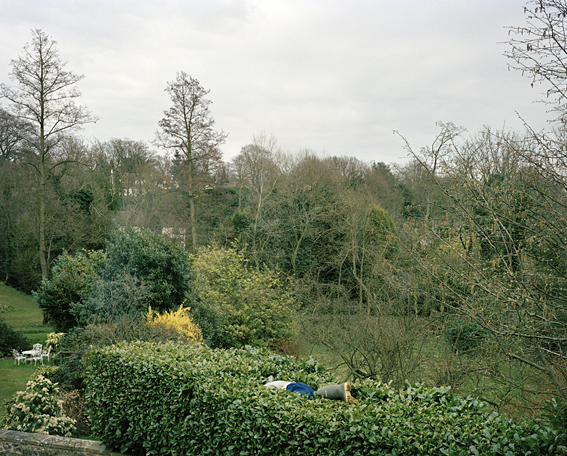
Â
Â
Posted in RESEARCH | 1 Comment »


